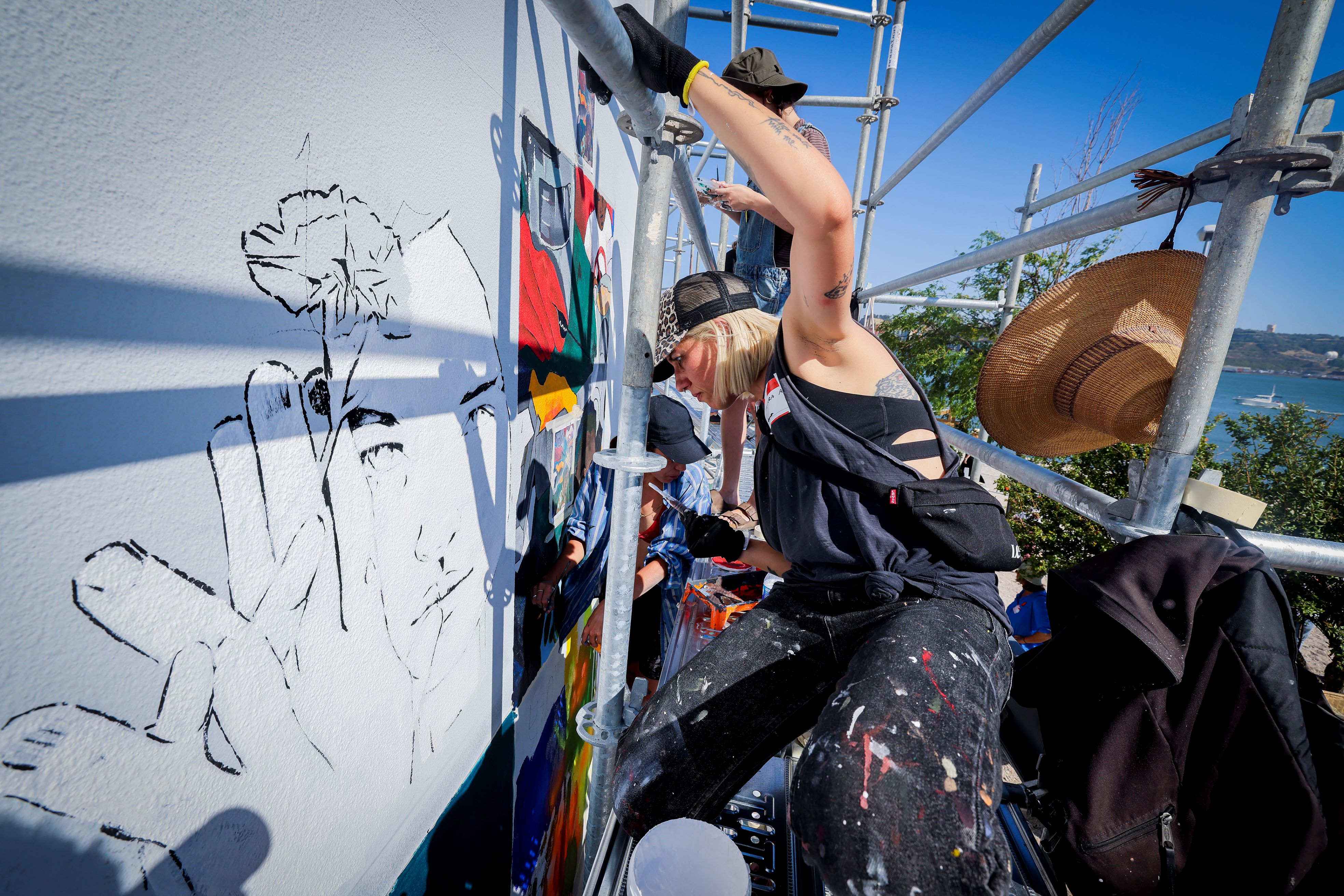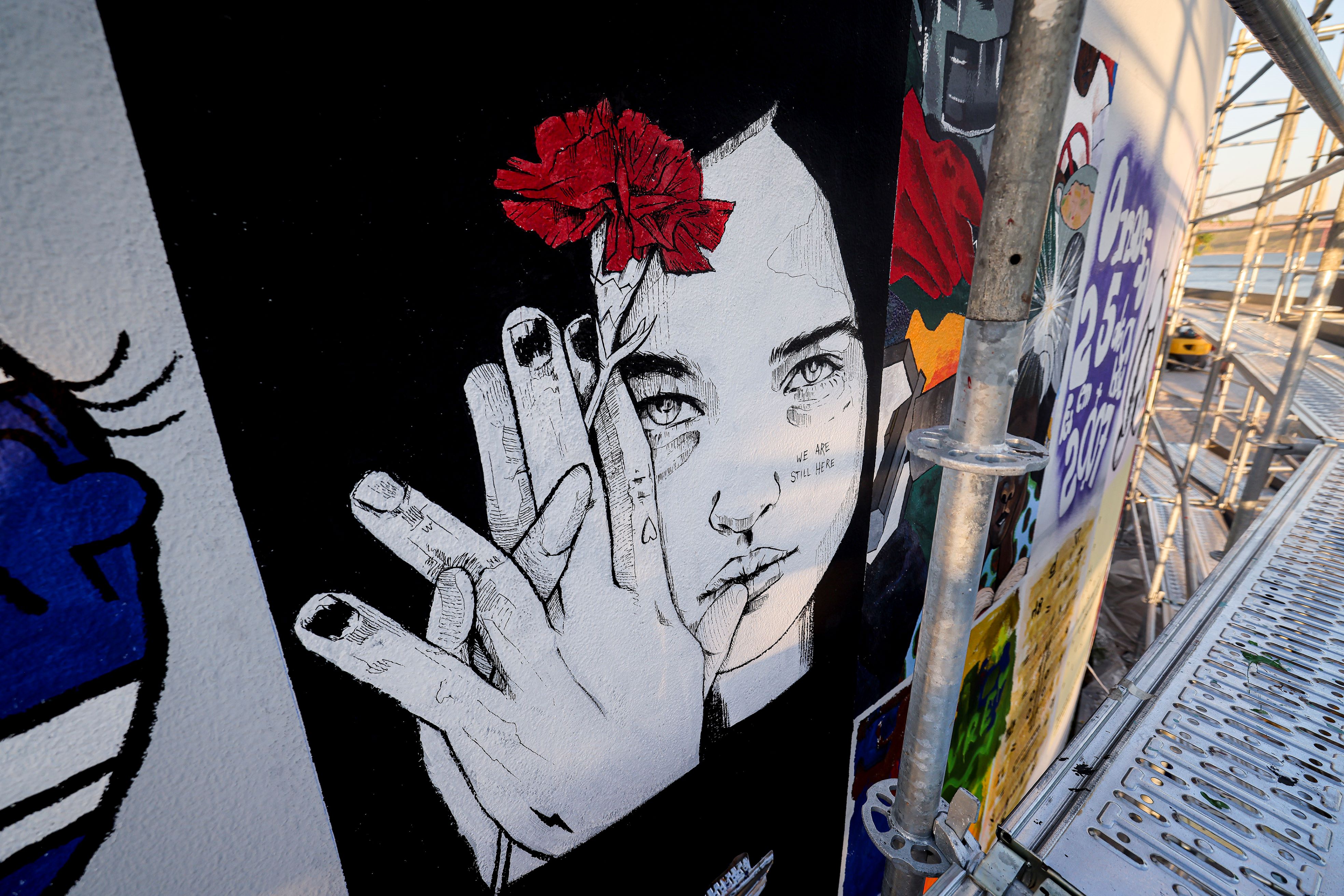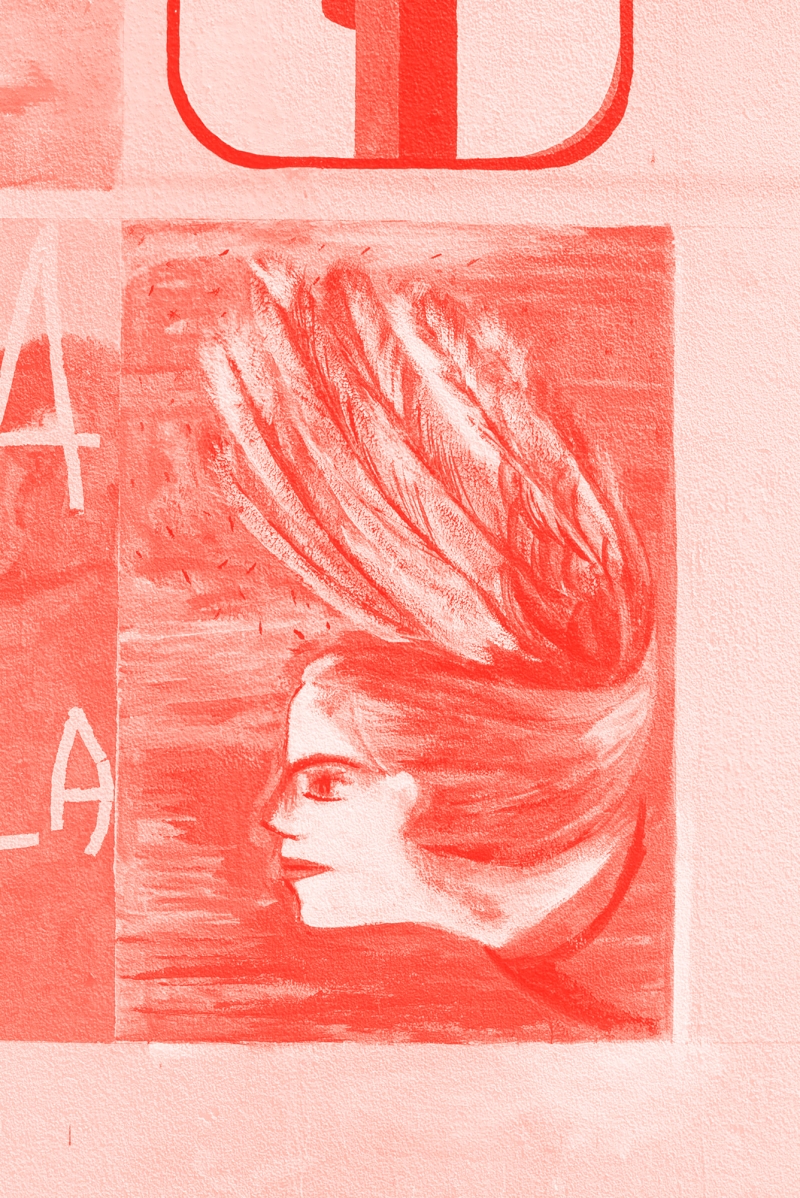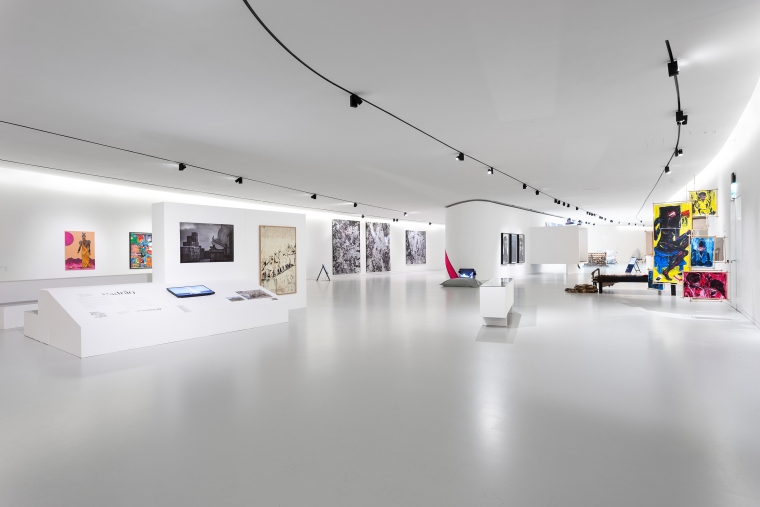TAMARA ALVES
48 artists, 48 years of freedom
Tamara Alves (Portimão, 1983) interviewed by Filipa Lowndes Vicente at maat on 10 June 2022, on the day the 48 artists, 48 years of freedom mural was painted
THE 25 APRIL 1974
I was born in ‘83. I inherited the freedom and values of 25 April through the experience and stories that marked the previous generation, that of my parents and grandparents. I think the first time I worked on the theme of 25 April was in 2014, for a competition called “25 de Abril Hoje” [25 April Today], in which Júlio Pomar was in the the jury, and I ended up winning and doing the mural. I don’t give obvious answers. I make people think. And I kept thinking about his words… why he chose my piece, with the way the figures were clutching the carnations? It ended up being a theme that I would keep coming back to and working on…
I did a huge mural… a massive 200-square-metre wall. The wall’s in Fórum Lisboa, in Avenida de Roma: Tamara Alves 25 de Abril Hoje [Tamara Alves 25 April Today]. Júlio Pomar went to the inauguration. It was an amazing experience, and I’m re-living that now… The mural had a very strong thematic component and it meant doing something I wasn’t used to. Without losing my identity, of course. In fact, the piece I’m doing here today is one I’ve done before.
PARTICIPATION ON THE MAAT MURAL IN 2022
Here, my female figure, who is grasping a carnation almost as if it were a weapon, is striking this pose…. I think the flowers can also be used as a metaphor, and not as a symbol of weakness but of strength. It’s a strength that I also use, but here in the form of a carnation – the symbol of 25 April, the symbol of the Revolution. I’ve been portraying women in a way that aims to change the way they’ve been portrayed throughout the history of art: always lying down, submissive, awaiting the observer’s gaze. I try to change that narrative, to put the female figure in control, awake, not lying down, sleeping, vulnerable, but awake and aware. Don’t look at her as prey but as a predator. In the sense that she controls the story. And I reinforce that. Today, I’m reinforcing the idea that here we are and here we’re going to stay, and it’s good to think and rethink about the word and the idea of freedom. To think about freedom. I think it’s important to keep thinking and working on this concept of freedom. Inner, spiritual freedom. Collectively, we humans are constantly seeking liberation. But here, obviously, it carries a different weight. A historical and political one. That weighed on the shoulders of many of those artists who were here before. We are trying to understand what happened, and we are trying to stop it happening again. I work with the Underdogs Gallery. They invited me to participate in the mural and I thought, yeah, fantastic! This is amazing. To relate to the earlier mural and the people who were part of it is to remake history.
That’s quite a responsibility. And to stand side-by-side with them... I can imagine what this means to them, because many who were here in ‘74 are no longer with us. And doing it with fresh blood and new ideas, and thinking about what freedom means today. And returning to the same themes. I can’t explain it… For me, this is a historic moment. I think it’s one of the most important things I’ve ever done. Or that I’m doing.
I have friends here, because, at least in the arts, it’s a small world. And “street art” is even smaller than that. But I have a lot of artist friends – from Caldas [da Rainha], from when I did my master’s. For example, Alice Geirinhas did her master’s with me. She’s here. And like her, there are various artists I’ve come across before or worked with who are in my area or are more conceptual. It’s interesting to have friends from my master’s course, from university and from the street.
Next to me, I have Sara and André, who studied in Caldas. They were a year ahead of me, but we remember each other. On the other side – I’m just talking about my neighbours, because I only arrived a while ago – I have Ângela Ferreira, who I’d never met. We talk and joke around. It’s cool, because I get it… I arrived recently, so I can feel what she’s dealing with, as she’s getting used to the wall and the method…
You feel an incredible energy around you and I’m really happy to be a part of this. I think that when we see the whole wall, I feel that I’m going to…. I’m talking to you and I’m already getting emotional. I think it’s going to be amazing.
TRAINING AND ARTISTIC CAREER: THE STREET AS A CANVAS
I’d already been invited to take part in some things for Underdogs, at Festival Iminente. The gallery invited me to do a solo exhibition, but after it finished, we went into lockdown. But otherwise I’ve always been independent. It was the first time I’d been associated with a gallery. But I think it’s the best one in the field of urban art; it makes sense for me.
My training was very academic. I studied for a degree in Caldas da Rainha. Many of the people who studied with me at the time are here. Then I did a master’s in contemporary art practices in Porto. After Porto, I came to Lisbon. I’d already chosen the street as my canvas, because it was an option at the time. It was either the galleries or trying to make it another way, and the street was an open-air gallery and non-elitist.
I’ve always been a loner. Only when I came to Lisbon did I start to meet other urban artists, but it was also at the time I came to Lisbon that it started to take off. I was part of the first wave, and I helped to get things moving…
Look, I’ve always loved drawing. Drawing is a big part of what I do. And books too. I like to think and read before deciding what I’m going to do. Then the sketch is quick. I really enjoy it. I love drawing. But I put a lot of thought into what I do. And sometimes I’m not so worried about the end result. But the process, yeah, that’s important to me.
I also write about what I do. I take a lot of notes. For most of the work I do, I have a synopsis and I end up telling a story. Or writing a poem. Something. I’m not a great writer, but I need to do it. It helps me, because I’m honest in what I write, and I’ve got used to doing it. I think it’s good therapy to get these things out.
BEING A WOMAN IN “URBAN ART”
I had a unique upbringing. My parents never told me I couldn’t do something. So I was never aware that there could be limits or different treatment. There were times when I knew that one of us – for example, we were five female artists – would have to play the role: “OK, we need a girl here.” And, sometimes, if there were three urban art festivals around the country, each of us would be at one of them every year. We were never all together; we were always filling holes. To the point where I was once paid to pretend I was painting, because they needed a female presence. At the time, stupidly, I accepted, because I needed the money. I’m even ashamed to admit it. I wasn’t even really aware. Then I started to think: “That was pretty bad.” But these days things are different. I remember that at the first Festival Iminente I took part in, women were in the majority. And that’s not normal. It was curated by Underdogs. It was by Vhils.
And even here [for the maat mural on 10 June 2022] you realise that… Don’t you feel it? I haven’t looked, but I think it’s very balanced in terms of gender…. That’s amazing.
You know that thing about women’s roles in society? There are many women who wouldn’t even consider being here and painting on a wall, or do anything, because it’s sort of: “No, I can’t.” But things have changed and I can feel it. I think it’s something we feel we’ve needed for a long time. And things are starting to appear and we’re starting to see them happen. And that’s incredible. Today, I walk past people of my generation who are here, and even younger ones too, who are also here…. There are lots of people who don’t feel that way, but I’m an optimist as far as future generations are concerned. I know that sometimes you have to push things a bit to make them happen, but I’m hopeful. I’m an optimist.
|
We Are Still Here is the portrait of a symbol of resistance and perseverance. A female figure holds a carnation close to her face, evoking the resilience of the people. It is a reminder that we are still here and ready to fight. Through her eyes, the times may have changed but the essence of our struggle for freedom remains the same. It is a constant quest that adapts itself to our spirits and the context in which we live.
|
48 artists, 48 years of freedom is the name of the artwork that will be symbolically created on 10 June 2022 in the maat Gardens, a collective mural intervention that reinterprets the work entitled Painel do Mercado do Povo [The People's Market Panel] created by the Movimento Democrático dos Artistas Plásticos [Plastic Artists for Democracy Movement] on 10 June 1974, in Belém. The reinterpretation of this mural, 24 meters long and 3 meters wide, has the participation of 48 artists: some of them participated in the creation of the original panel and the others are artists who stood out in the Portuguese art scene during the last 48 years of democracy in Portugal, an anniversary celebrated this year, and some of them are part of the exhibition Interferences: Emerging Urban Cultures (maat, 30/03–05/09/2022).
|



Tamara Alves at maat, during the painting of the mural 48 artists, 48 years of freedom, 10 June 2022. Photos: Daniel Rocha.










